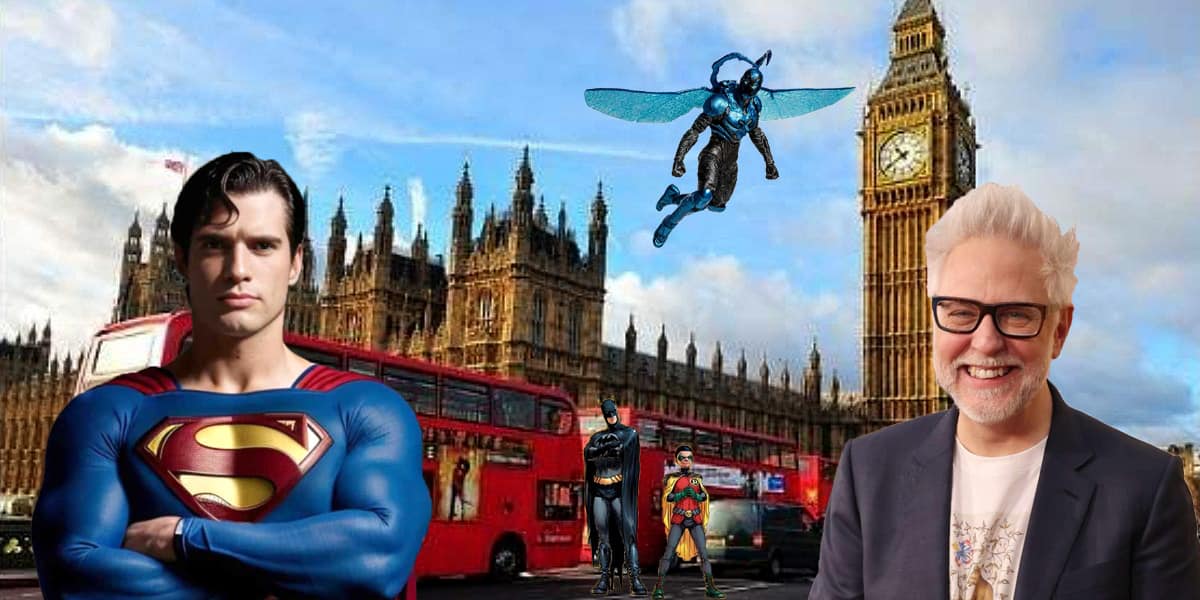The co-chief of the recently revamped DC Studios, James Gunn, announced the new direction for the DC cinematic universe (DCU) back in January. Since the monumental regime change, multiple changes have been enacted, from an entirely new phase of DC character films to the cancellations of several others to now a massive move “across the pond” to the Warner Bros. studio in Leavesden, U.K.
Credit: Chris Pizello/Invision/AP/Shutterstock
James Gunn and co-chief Peter Safran certainly have the painstaking task of having to reshape the entire DC cinematic brand. Warner Bros. originally introduced audiences to the first DC Comics-inspired cinematic universe with Zack Snyder’s Man of Steel in 2013. This success would enact the era of the DC Extended Universe (DCEU). It was intended to be the direct competitor to the thriving Marvel Cinematic Universe.
Credit: Warner Bros.
Snyder’s vision for the DCEU would raise eyebrows at Warner Bros. when Batman v. Superman (2016) failed to meet box office expectations. This distrust in his creative direction hit its climax with the theatrical release of Justice League (2017). Joss Whedon was brought on to rewrite and reshoot a large portion of the film by studio executives. This would spawn a tonally and narratively different final cut than Snyder’s version. The filmmaker left Warner Bros. and only returned to finish his cut of Justice League.
Credit: DC Studios/Warner bros.
The DCEU would ultimately end up in 15 films, three of which were released this year – Shazam: Fury of the Gods, The Flash, and Blue Beetle. Even with this progression, the inconsistency in storytelling and quality filmmaking led to a continuous fall in box office returns.
Credit: ITM
These missteps would eventually prompt to the decision to restructure leadership. Gunn and Safran’s promotion implied that the existing iteration of the DCEU was at the end of its rope. The definitive stamp to this speculation was made clearer when Henry Cavill was confirmed to not be reprising his role as Superman. A choice that sparked confusion amongst audiences after his cameo in the end scene credits of Black Adam.
Credit: Warner Bros
While it is uncertain what will happen to Ezra Miller in The Flash or Jason Mamoa’s Aquaman and The Lost Kingdom, it was confirmed that Blue Beetle will carry over and be the first DCU superhero. James Gunn would also announce that the DCU will unfold in different, connective chapters with the first part being called — Chapter 1: Gods and Monsters.
Credit: AS USA
Before this new chapter starts, Warner Bros. Discovery (WBD) will be providing DC Studios with a permanent primary production hub at their studio in England. Even though this studio was mainly used for WB’s U.K.-based TV and film projects, like Harry Potter and House of the Dragon, it will be the new epicenter for the future of DC.
Credit: British Cinematographer
There will also be a colossal expansion plan that will increase the studio’s territory by 50%, which will include 10 new sound stages. WBD has stated that the expansion will create 4,000 new direct and indirect jobs across the U.K. This will contribute to the British economy at total of £600 million annually. Construction is scheduled for 2024 until 2027.
Credit: British Cinematographer
Before the big move, Gunn will initiate the DCU’s first chapter by writing and directing Superman: Legacy. Andy Muschietti will helm Batman: The Brave and The Bold and James Mangold will lead Swamp Thing. The two remaining movies that are part of the Gods and Monsters Chapter are The Authority and Supergirl: Woman of Tomorrow. There have been no updates on who will write or direct the last two entries, but rumors have circulated that The Flash‘s Sasha Calle could reprise her role as Supergirl.
What do you think of the news? Will more studios be moving out of the U.S. to escape the bureaucracy of the strikes and tax rebates?
DC’s American superheroes are moving “across the pond.” #dcstudios #dcu #dceu #jamesgunn #warnerbros Read More

